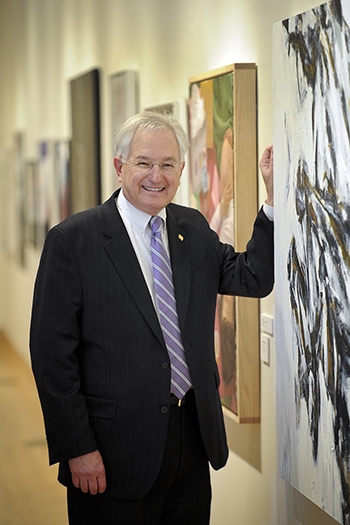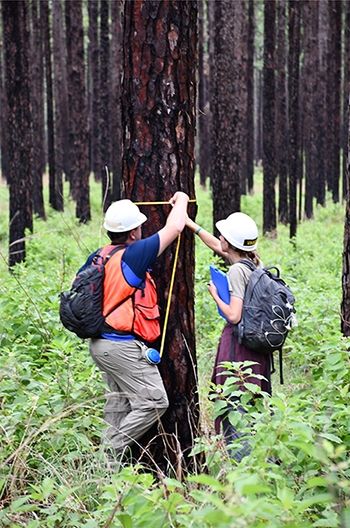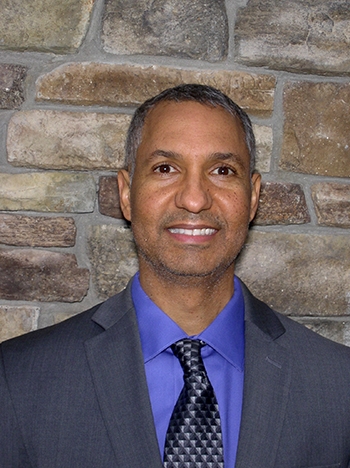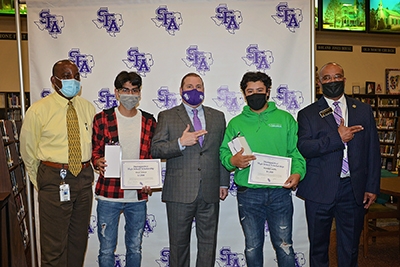SFA University
April 19. 2021 – Metalworking and jewelry students from Stephen F. Austin State University, Dallas College, New Mexico State University and the University of Texas at El Paso collaborated in a semester-long technical process to create and trade metal brooches.
Practicing the historical process of lost wax casting, the students created original designs by carving wax, according to Lauren Selden, professor of metal/jewelry at SFA. The project was designed to help students learn to problem solve, be persistent and work in a condensed time frame.
“After placing the flasks filled with refractory material and the original wax in a kiln, students cast original forms in bronze into the void left from the melted wax,” Selden explained. “Each artist created rubber molds and wax additions of the original. Participants made a brooch for all of their classmates as well as the three participating universities.”
In addition to Selden, professors Natalie Macellaio, Motoko Furuhashi and Jess Tolbert shared project guidelines and technical tips and had a “Pin Pals Symposium” lecture discussing their personal artwork with all the participating students. Each professor provided an exhibition space in their respective towns of Nacogdoches, Farmers Branch and El Pass in Texas and Las Cruces, New Mexico. Each university will keep the finished pin collection for their programs’ permanent collection. SFA students’ work will be displayed in the window of The Cole Art Center @ The Old Opera House beginning April 22.
“In a time where we haven’t been able to travel and see one another,” Selden said, “these tiny pins have traveled hundreds of miles in order to do what jewelry is often charged to do: bring joy and be a reminder of community.”
A collective virtual lecture is planned for 6pm Monday, April 26, accessible on Zoom. For inquiries, contact lselden@sfasu.edu.
Participating artists included:
SFA: Professor Lauren Selden; Amber Barrett, Kingwood sophomore; Kevin Burgess, San Antonio senior; Kailan Counahan, Rusk graduate student; Lindsey Creel, Austin graduate student; Miguel Gonzalez, Georgetown junior; Kitty Hall, Melissa senior; Heath Pyle, Dallas senior; Morgan Ray, Center senior; Brendan Ryan, Cedar Park junior; and Michelle Salerno, Cypress senior.
Dallas College: Professor Natalie Macellaio, Kenya Diaz, Nomaan Mohammed, Ofelia Alvarenga, Raul Najera, Lily Chenbuynak, Daniel Townzen, Maria Villa Reyes, Rebecca Kim, Andrea Robinson, Ray Lavin, Kelaine Kvale and Douglas Jochum.
New Mexico State University: Professor Motoko Furuhashi, Tessa Bond, Paola Corchado, Mathew Deed, Sadie Esquer, Betty Hase, Julieanna Lerma, Everlyn Padilla, Nicholas Quartieri, Trisha Quintero, Cierra Redding, Ruben Reyes and Ger Xiong.
University of Texas at El Paso: Professor Jess Tolbert, Brandon Contreras, Andres Delgado, Ivan Esparza, Roxy Gonzalez, Noelle Marquez, Jess Ceballos, Jess Rivera, Mikayla Fraire, Skylar Boone, Roxy Rodriguez, Robbie Vazquez, Caro Villarreal, Alan Maguregui, Diane Morales and Gaby Alvarado.
For more information about this project and others in the SFA School of Art, call (936) 468-4804. The Cole Art Center is located at 329 E. Main St.

The results of a project in which SFA metal/jewelry students collaborated in a semester-long technical process to create and trade metal brooches with three other universities will be displayed in the window of The Cole Art Center @ The Old Opera House in downtown Nacogdoches starting April 22.
April 19, 2021 - The Stephen F. Austin State University School of Music will present its Concert in the Park at 2pm Sunday, April 25, in the wooded area between Wright Music Building and the Baker Pattillo Student Center on campus.
The outdoor concert, featuring all SFA wind bands, is a community favorite but was canceled last year because of COVID-19.
Featured bands include the Wind Ensemble, directed by Dr. David Campo, director of bands at SFA; the Wind Symphony, directed by Dr. Tamey Anglley, associate director of bands and director of the Lumberjack Marching Band; Symphonic Band, directed by Dr. Chris Kaatz, assistant director of bands; and the University Band, directed by graduate conductors Felipe Hernandez of Lufkin, Jacob Bridges of Lake Charles, Louisiana, and Abbigail Ramsey of Prosper.
Kappa Kappa Psi and Tau Beta Sigma band organizations will sell food and band apparel as a fundraiser. Safety protocols such as facemasks, gloves, social distancing and hand sanitizer stations will be in place.
Attendees are encouraged to bring lawn chairs or blankets for seating. Admission is free. For more information, contact the School of Music at (936) 468-4602.
April 19, 2021 – Stephen F. Austin State University graduate Richard Robichaux has landed a role in the new Disney+ show “Big Shot,” an original series streaming April 16.
“Big Shot,” which stars John Stamos and Yvette Nicole Brown, is the story of second chances for a hot-headed coach (Stamos) who loses his big time collegiate coaching job in the NCAA and has to start all over by teaching at a girl’s private high school.

“Big Shot,” a new Disney+ original series streaming April 16, stars John Stamos and Yvette Nicole Brown and also features SFA theatre alumnus Richard Robichaux ’96, far right, playing the role of a school counselor.
“It is also a story of second chances for his relationship with his daughter and for every character in the show who seem to all be trying to start something new,” Robichaux said.
 Robichaux, who graduated from SFA in 1996 with a B.F.A. in theatre, has been seen in the films “Boyhood,” which was nominated for six Academy Awards and won the Golden Globe for Best Picture; “The Book of Love,” with Jason Sudeikis and Jessica Biel with all original music by Justin Timberlake; “Bernie,” opposite Shirley MacLaine, Jack Black and Matthew McConaughey; as well as extensive television credits, including “Unbreakable Kimmy Schmidt.” Recent credits include “Ocean’s 8,” the ABC comedy “Speechless,” and “Where’d You Go Bernadette?” with Cate Blanchett, marking Robichaux’s fourth film with award-winning director Richard Linklater.
Robichaux, who graduated from SFA in 1996 with a B.F.A. in theatre, has been seen in the films “Boyhood,” which was nominated for six Academy Awards and won the Golden Globe for Best Picture; “The Book of Love,” with Jason Sudeikis and Jessica Biel with all original music by Justin Timberlake; “Bernie,” opposite Shirley MacLaine, Jack Black and Matthew McConaughey; as well as extensive television credits, including “Unbreakable Kimmy Schmidt.” Recent credits include “Ocean’s 8,” the ABC comedy “Speechless,” and “Where’d You Go Bernadette?” with Cate Blanchett, marking Robichaux’s fourth film with award-winning director Richard Linklater.
"To say the School of Theatre is proud to have Richard as both an alumnus and a Friends of Theatre member goes without saying,” Cleo House, School of Theatre director, said. “Richard is such a great example of the longstanding tradition the School of Theatre has of turning out top-notch graduates who go on to be successful."
In “Big Shot,” Robichaux plays George Pappas, a school counselor, which allows him to call on his experience as an educator. In addition to continuing to earn roles on the big and small screens, Robichaux is a member of the M.F.A. acting faculty at the University of California San Diego. Playing Pappas means he “gets to be in the middle of a lot of stuff and meddle,” he said.
“Being an actual educator has been a great asset because so many of the cast are the age of the students I work with,” he said. “It’s been a pleasure to be colleagues with young actors whom I am usually only teaching.”
The series also stars Jessalyn Gilsig, Sophia Mitri Schloss, Nell Verlaque, Tiana Le, Monique Green, Tisha Custodio and Cricket Wampler. It was created by David E. Kelley, Brad Garrett, and Dean Lorey who also serve as executive-producers alongside Bill D'Elia.
Robichaux described Stamos and Brown as “everything you would want them to be.”
“Kind, genuine, thoughtful, so funny and supportive of the whole team,” he said, “especially when Covid hit and things were so hard, they were constantly texting the cast to keep up the good work and keep spirits high. They are two of the best actors in television right now, hands down.”
 “Richard is one of the most pliable actors I’ve ever worked with, and that is a high compliment,” Stamos said. “On our new Disney+ show, his character George started out one way, then David Kelley decided to take a complete 180 with George. Without missing a beat, Richard created (recreated) a character to rival my Marvyn, resulting in some of my favorite scenes on our show. To act with him is like playing music with a great musician or sports with a great athlete. He listens. I throw him a fastball; he catches it, then lobs something at me that either challenges me or makes me laugh. He’s a consummate pro who I learn something from every time I act with him. He’s a great family man, and I admire that too.”
“Richard is one of the most pliable actors I’ve ever worked with, and that is a high compliment,” Stamos said. “On our new Disney+ show, his character George started out one way, then David Kelley decided to take a complete 180 with George. Without missing a beat, Richard created (recreated) a character to rival my Marvyn, resulting in some of my favorite scenes on our show. To act with him is like playing music with a great musician or sports with a great athlete. He listens. I throw him a fastball; he catches it, then lobs something at me that either challenges me or makes me laugh. He’s a consummate pro who I learn something from every time I act with him. He’s a great family man, and I admire that too.”
Brown described Robichaux as “joy walking.”
“He makes every day on set fun,” she said. “And he’s such a great actor that even if I know what his lines are, I never know what bit of silliness or gravitas or magic he’s going to bring to them. The gift of working with him has been a masterclass.”
Robichaux continues to keep up his teaching schedule while working on the new series.
“Since our show is only 10 episodes, and I am usually in just a few scenes per show, it hasn’t been hard on my schedule,” he said. “It shoots in L.A., so that certainly helps. Also, UCSD is one of the best research institutions in the world. I am not only encouraged but expected to do big things in my field of research.”
He said he wants SFA theatre students to know it’s possible for theatre graduates be successful on many different levels.
“I always want SFA students to know that this is possible,” he said. “I’m the perfect example. I was a first generation college student from a small town in Texas, and now I hold the endowed chair in acting at one of the most respected M.F.A. acting programs in the world, and I will also be on your TV this month. That all started with a degree from SFA.”
Robichaux came to Nacogdoches in the early 1990s from Channelview, an oil refinery suburb of Houston. He earned a Master of Fine Arts from Rutgers University, has worked with many of the top programs in the country and is a nationally recognized leader in actor training. He is an outspoken advocate for theatre education and has delivered keynote addresses at several events, including the Southeastern Theatre Conference, Texas Thespian Festival, Florida Association of Theatre Educators, Heartland Film Festival, Colorado Thespian Festival, and the Educational Theater Association's National Teacher Conference. He is also a judge for the College Television Awards presented by the Emmys. Robichaux was the head of acting at Penn State University prior to his arrival at UCSD where he teaches acting process to M.F.A. actors as well as a course on professional practice and on-camera acting.
April 9, 2021 — The chaos of an intensive care unit has been depicted in movies and TV shows for decades, and students in Stephen F. Austin State University’s School of Human Sciences got one step closer to experiencing the real thing in their medical nutrition therapy II course.
Designed to expose students to all the equipment they will encounter in a clinical environment for patient care, the course is held in a simulated ICU room at SFA’s DeWitt School of Nursing.
“This lesson is important for these future registered dietitians to integrate nutrition into the treatments they’ll encounter in the real world,” said Justin Pelham, clinical instructor of food and nutrition at SFA. “And I want them to feel comfortable in a chaotic environment.”
With the help of a mannequin that breathes and blinks, students reviewed the numerous tubes and cannisters that support a patient and present the greatest risk of infection if not handled correctly. From sodium chloride and lipid bags to total parenteral nutrition, or “steak and potato,” bags, the students explored intravenous feeding and hydrating.
“By attending the simulation, I feel more prepared for what I will be seeing and experiencing in the real world before I graduate,” said Paige Pierce, a nutrition senior from Sachse. “It is one thing to talk about TPN and calculate tube feeding in class, but to actually see TPN bags and the machine they are hooked up to helped enhance my understanding.”
The COVID-19 pandemic has presented special challenges for ensuring a patient’s nutrition needs are met.
Patients with COVID-19 generally require supplemental oxygen through breathing treatments and the use of oxygen masks and nasal cannulas, Pelham said.
“At this point, patients can still eat and digest their food. The food may need mechanical softening — chopping or pureeing in a blender — but the patients can still eat it,” he said. “Once they’re on a ventilator, though, there’s no room to feed them by mouth anymore. Nutrition has to be implemented via the gastrointestinal tract or intravenously as a last resort.”
Students in the course also examine the nutrition care process for other conditions, including cancer, diabetes, human immunodeficiency virus, liver disease and renal disease. This visual application of the simulation helps students see how to integrate the clinical equipment, roles of the interdisciplinary health team and the necessity for proactive nutrition interventions for these conditions.
“We want our dietetic students feeling confident at the next stage in their clinical rotations of their dietetic internship,” Pelham said.
For more information on SFA’s food, nutrition and dietetics program, visit sfasu.edu/nutrition.
As part of their training to be registered dietitians, students in Stephen F. Austin State University’s food, nutrition and dietetics program explored the nutrition provision process in a simulated intensive care unit at SFA’s DeWitt School of Nursing with help from Justin Pelham, clinical instructor in the School of Human Sciences. The simulation is designed to help them feel comfortable in a chaotic environment. (Photo by Dr. Shirley Luna.)
April 9, 2021 – Dr. A.C. “Buddy” Himes, dean of the College of Fine Arts at Stephen F. Austin State University, will retire effective May 31 after 47 years of service in both secondary and higher education.
 In notifying the dean’s staff and fine arts faculty members last fall of his intended retirement, Himes wrote: “I am grateful to Stephen F. Austin State University for allowing me the honor and privilege to serve as dean of the College of Fine Arts for the past 14 years. I feel that coming together in unity, the university, the faculty and staff, and the community have allowed the college to be taken to the next level multiple times over.
In notifying the dean’s staff and fine arts faculty members last fall of his intended retirement, Himes wrote: “I am grateful to Stephen F. Austin State University for allowing me the honor and privilege to serve as dean of the College of Fine Arts for the past 14 years. I feel that coming together in unity, the university, the faculty and staff, and the community have allowed the college to be taken to the next level multiple times over.
“Reflecting upon my career it is obvious (to me) that every challenge has been met, every goal accomplished, every expectation exceeded, and every vision realized,” he said. “And, now, after 47 years in the profession, this is clearly the ideal time for me to retire.”
SFA President Scott Gordon praised Dr. Himes’ commitment, hard work and vision, noting the thriving and vibrant community created within the SFA College of Fine Arts.
“The leadership he has provided will continue to impact SFA students for years to come, and we are grateful for his accomplishments as dean,” Gordon said. “Dr. Himes has been an asset to our campus and the Nacogdoches community, and we wish him all the best in his retirement.”
Himes came to SFA to serve as the fine arts dean in 2007, moving from the University of Louisiana at Lafayette where he was director of the School of Music and head of the Department of Performing Arts in the College of the Arts. There, he was recognized for his oversight of a construction project, doubling the fine arts endowment base, producing a community-based organization dedicated to enhancing scholarships, and attracting nearly $1 million in grants.
Following the same pattern for success, Himes has guided the schools of art, music and theatre at SFA to higher levels of achievement during his 14-year leadership.
Perhaps his greatest accomplishment at SFA is currently being realized and taking shape today before the public eye, its daily evolution apparent at the corner of North Street and East College Street. In 2015, Himes released “The Transformative 2020 Vision,” a five-year plan for a multi-million-dollar project designed to “transform the College of Fine Arts into the best fine arts program in Texas.” The plan led to the approval by the SFA Board of Regents for the $50-million renovation and expansion of the Griffith Fine Arts Building currently underway. Funding was obtained through the issuance of bonds in 2019, and proceeds must be used, in accordance with the bond documents, for construction, renovation and other project-related purposes.
“With these new facilities, the College of Fine Arts will be able to fully alleviate concerns for space, grow to its potential in enrollment, be competitive with similar programs in Texas, and fully capitalize upon student markets for new programs,” Himes said. “As much as the college has grown in enrollment over the past decade, I predict an explosion of new enrollment in fine arts in the next decade, notwithstanding the immediate effects of a pandemic.”
More than two decades in the making, the $50-million Fine Arts Expansion Initiative will include complete renovations to the existing Griffith Fine Arts Building and add accessible parking, a patron drop-off zone (off East College Street) and new construction which will extend the building along North Street nearly to the corner of East College Street. The renovated and expanded state-of-the-art building will include two dance studios, two theatres, an auditorium, recording studio, sound stage, audio and video editing rooms, an art gallery, multiple classrooms, rehearsal facilities, faculty offices and the offices of the dean. The facilities will house the CFA’s sound recording technology, filmmaking, theatre, dance and musical theatre programs.
Following his arrival at SFA, Himes in 2008 established the Dean’s Circle, an external support organization of community members dedicated, in part, to nurturing potential young artists within the College of Fine Arts. The Dean’s Awards include monetary rewards to students to further their educational pursuits. Since 2008, the Dean’s Circle has presented $174,000 in student awards. Additionally, the organization established the first-ever community-established endowed professorship at SFA in 2016.
Himes was instrumental in establishing the Sound Recording Technology program within the School of Music. “I can trace this program back to April of 2007 when I came to interview,” he said. “It began as nothing more than what was known to be a good idea, and a whole lot of faith – no curriculum, no facilities, no equipment and no students. Today, the SRT program is certainly the fastest growing program in the School of Music, and is one of, if not the, fastest growing programs at the entire university.”
Among his other SFA accomplishments are involvement in the restoration of SFA’s bell carillon, creation of three endowed professorships, a permanent endowment for the College of Fine Arts’ generation of $125,000 in unrestricted monies annually, a 23% increase in enrollment within the college, successful advocacy for the new $50-million fine arts expansion underway, construction of 16 new music practice rooms, involvement in the production of the Nacogdoches 1938 documentary film project, and bringing the dance program into the College of Fine Arts.
Throughout his career, Himes has been a sought-after conference presenter and panelist. He is a published author on topics of administrative leadership and teaching effectiveness, and he has served in leadership roles in academic organizations at the national and international levels.
Himes has served his community through active engagement in the Rotary Club, was a founding member of the Nacogdoches Film Festival, and is a member of First United Methodist Church, where he actively engaged in the pipe organ restoration project.
After graduation from college in 1973, Himes began his career as a high school band director in Bluefield, West Virginia.
Himes and his wife, Cindy, plan to stay active in the Nacogdoches community and enjoy their children and grandchildren.
April 5, 2021 - Registration is now open for Stephen F. Austin State University’s Conservation Careers Camp hosted by the Arthur Temple College of Forestry and Agriculture.
The camp, held June 20 to 24, is open to students age 14 to 17 who are interested in exploring career opportunities in natural resource management through engaging, hands-on experiences led by SFA professors and industry professionals.
“The vision of the Conservation Careers Camp is to have fun while connecting high school students to the forest and natural world,” said Chanelle Svehla, academic advisor in SFA’s Arthur Temple College of Forestry and Agriculture. “Through hands-on learning programs, campers will gain knowledge about environmental stewardship, land ethics and forest health.”
Camp activities will focus on air and water quality monitoring, unmanned aerial vehicle operation, timber cruising, wildlife identification and management techniques, and more. Field trips also will introduce campers to surrounding national forests, as well as properties managed by SFA.
“Our camp is a unique opportunity for students to fully immerse themselves in the diverse field of natural resource management and experience what it is like to be a student within our college,” said Dr. Hans Williams, dean of the Arthur Temple College of Forestry and Agriculture.
The cost of the camp, including housing, field trips and dining, is $375. Campers who register prior to April 20 will receive a $100 scholarship toward registration. The registration deadline is May 20.
Registration information and required forms can be found at www.sfasu.edu/cccamp. For more information, contact Svehla at Chanelle.Svehla@sfasu.edu or (936) 468-2351.

Registration is now open for Stephen F. Austin State University’s Conservation Careers Camp hosted by the Arthur Temple College of Forestry and Agriculture. The camp, held June 20 to 24, is open to students age 14 to 17 who are interested in exploring career opportunities in natural resource management through engaging, hands-on experiences led by SFA professors and industry professionals.
March 24, 2021 - In partnership with Stephen F. Austin State University’s Office of Multicultural Affairs, SFA Hillel, a student group that builds connections with emerging adults and inspires them to direct their own Jewish journey, will host the university’s first official Holocaust Remembrance Day event, or Yom Hashoah in Hebrew, on April 8 as part of the OMA’s Diversity Week event slate.
Hungarian Holocaust survivor Dr. Zsuzsanna Ozsváth will be the event’s keynote speaker. She will share her Holocaust experience and engage in a Q&A with attendees.
Dr. Michara DeLaney-Fields, SFA’s chief diversity officer, and Rabbi Kenny Weiss, executive director of Houston Hillel, also will be introductory speakers at the event.
“The purpose of Yom Hashoah is to keep the memory of the horrific events of the Holocaust alive, and this year participants will be able to do that by listening to Holocaust survivor Dr. Zsuzsanna Ozsváth,” said Jade Gordon, co-president of SFA Hillel, formerly known as the Jewish Student Union.
“It is important to recognize this day because it is how the Jewish people keep the memory of the Holocaust alive by hearing the stories and passing them on, especially in a time like today that has become difficult for Jews all over again because of the rise in anti-Semitism.”
Ozsváth founded the Holocaust Studies Program at The University of Texas at Dallas and is professor emeritus of literature and history and the former Leah and Paul Lewis Chair of Holocaust Studies. She joined the UT Dallas faculty in 1983, initially teaching 19th- and 20th-century literature and history classes.
“We are fortunate to have Dr. Zsuzsanna Ozsváth, affectionately known as Zsuzsi, share her personal memories of the Hungarian Holocaust with our students and community,” said Dr. Flóra Faragó, SFA Hillel advisor and associate professor in SFA’s School of Human Sciences. “Zsuzsi's story reflects what happened to my family and to hundreds of thousands of Jewish families in Hungary and larger Europe. Learning about the Holocaust will remind us how far we have come and yet how far we have to go to achieve justice, dignity and equality for all."
While known for her Holocaust classes, Ozsváth has published a number of articles dealing with aesthetic and ethical issues in French, German and Hungarian literature as well as with the relationship between art and totalitarian ideology. As a scholar, critic, and translator, Ozsváth has extensively written about Holocaust literature and the Holocaust in Hungary. Her memoir, “When the Danube Ran Red,” tells the chilling and extraordinary story of her childhood in Hungary, living under the threat of the Holocaust.
“Event participants will be encouraged to reflect on how current and historical anti-Semitism shapes the lives of Jews and non-Jews alike and learn about incredible stories of survival, loss and resistance,” Gordon said. “The hope is that this event will inspire participants to take action against anti-Semitism and other -isms that continue to impact the lives of millions in the U.S. and around the world.”
SFA Hillel’s Holocaust Remembrance Day will be held in person and via Zoom beginning at 6pm April 8. The in-person event will take place in the Baker Pattillo Student Center Grand Ballroom on the SFA campus. Following the keynote speaker, in-person attendees will be able to participate in an activity to honor the 1.5 million children killed during the Holocaust.
As a supplement to the event, Gordon also will host a Lumberjacks Live Q&A on SFA’s Instagram account, @sfasu, at 6pm April 1. She will speak with Shirley Watterston, retired SFA lecturer of music and vocal coach accompanist, about her own history living as a Jewish individual in East Texas and personal remembrances of the Holocaust.
SFA’s Holocaust Remembrance Day was made possible through assistance from Hillel Houston and Hillel at Home.
There is no fee to attend either in person or online; however, registration will be required for Zoom attendees. To register for the Zoom event, visit form.jotform.com/210754475322150. The deadline to register is 6pm April 7.
In-person attendees will be required to abide by SFA’s mask requirement and maintain a safe physical distance.
For more information about OMA’s slate of Diversity Week events, visit sfasu.edu/oma. For SFA Hillel information and updates, follow the organization on Instagram @sfa_jsu.
March 19, 2021 - Lorenzo M. Smith, Ph.D., professor and dean of the College of Engineering and Computer Science at California State University, Sacramento, will be Stephen F. Austin State University’s next provost and executive vice president.
 Smith earned a bachelor’s degree in mechanical engineering from the University of Illinois at Urbana-Champaign; a master’s from Wayne State University in Detroit, Michigan; and a doctorate in engineering mechanics from Michigan State University.
Smith earned a bachelor’s degree in mechanical engineering from the University of Illinois at Urbana-Champaign; a master’s from Wayne State University in Detroit, Michigan; and a doctorate in engineering mechanics from Michigan State University.
“Dr. Smith is a visionary, proven leader with a passion for advancing student, staff and faculty success,” said Dr. Scott Gordon, SFA president. “He has thrived as a faculty member and as a dean, and we look forward to the leadership he will provide as provost and executive vice president at SFA.”
Prior to his service at Sacramento State, Smith was a faculty member at Oakland University from 2000 through 2011 and taught courses ranging from the mechanics of metal forming to the theory of plasticity. He served as associate dean from 2011 through 2014.
Under his leadership, four of the college’s programs advanced from unranked categories and are now highly ranked, and a multi-faceted student success center was created to facilitate academic advising, tutoring, student internships and career services. During the COVID crisis, Smith implemented the delivery of take-home learning kits to facilitate off-campus learning for students.
Smith has authored approximately 60 publications and secured $7 million in external funding to support his research and scholarly activity. Additionally, he collaborated with students, staff and faculty to create and execute two college-level strategic plans that led to successful fundraising efforts totaling $5.6 million for the institution.
In 2019, Smith became the founding chair of the CSU Engineering Deans Council, which was formed to advocate collectively for 20 engineering deans across the university system. That same year, he received the American Society of Civil Engineering – Sacramento Chapter Jonathan Burdette Brown Education Award.
He has served as president of the board of directors of the Oakland Youth Orchestra and the Sacramento Youth Symphony and has been a member of the Sacramento Black Chamber of Commerce and a Little League Baseball coach.
Smith will assume his role June 1 and will succeed the current provost, Dr. Steve Bullard, who recently announced his plans to retire from the university.
March 17, 2021 - Stephen F. Austin State University announced the creation of its Distinguished High School Program Tuesday and named Nacogdoches High School as one of five partner schools across Texas.
Inclusion in the program means all students from NHS and partner schools may waive the $50 application fee, and seniors ranking in the top 30% of their class are guaranteed admission to SFA.
Students from partner schools also will automatically receive scholarship money for up to four years based on their class rank. Of those who apply to SFA from distinguished program schools, students ranking in the top 10% of their class will receive $5,000 per year, and students ranking in the 11-25% of their class with a 3.0 GPA or higher will receive $3,000 per year. Submission of a scholarship application is not required.
“At SFA, we are fully committed to student success and access, meaning we are constantly seeking new and innovative ways to ensure Texans have affordable access to higher education,” said SFA President Dr. Scott Gordon. “Our newly introduced Distinguished High School Program recognizes hardworking high school students by helping them obtain their college degree in a more timely and affordable manner. We are thrilled to offer this new program.”
Other benefits for students at distinguished program partner schools include additional financial aid assistance to students with high financial need; a special, tailored campus visit; and an assigned admissions counselor to serve students throughout the college-enrollment process.
“This is an incredible opportunity for our students that will both increase access and simplify the process of attending college,” said Dr. Gabriel A. Trujillo, Nacogdoches Independent School District superintendent. “Not only will our students have access to a streamlined application process, they will be eligible for automatic qualification and have an opportunity to obtain much-needed financial support.
“We’re grateful for SFA’s willingness to include Nacogdoches ISD, a move that will only improve upon a partnership that’s already proven fruitful to our community.”
Other Distinguished High Schools invited to partner in SFA’s new program include Center High School, Langham Creek High School, Little Elm High School, Tomball Memorial High School and Allen High School.
Students from distinguished program schools applying as first-time freshmen at ApplyTexas.org also should submit official SAT/ACT scores and high school transcripts to the SFA Office of Admissions. For more information about applying to SFA, visit sfasu.edu/apply or call (936) 468-2504.

Stephen F. Austin State University announced the creation of its Distinguished High School Program Tuesday and named Nacogdoches High School as one of five partner schools across Texas. NHS seniors Oscar Tinoco and Ronald Castillo were recognized as two of the first program awardees and received scholarships of $3,000 per year and $5,000 per year, respectively. Pictured, from left, are interim NHS principal Dr. Kenneth Matthews, Tinoco, SFA President Dr. Scott Gordon, Castillo, and NHS deputy superintendent Michael Martin.
March 3 2021 - Researchers at Stephen F. Austin State University’s Arthur Temple College of Forestry and Agriculture are working with the National Park Service and Florida State Parks to ensure the history and stories of African Americans and other people of color are properly represented in interpretive site programming.
Arkansas Post National Memorial, located near Gillet, Arkansas, is situated at the confluence of the Arkansas and White rivers, and is the traditional homeland of the indigenous Quapaw people.
In 1686, French explorer Henri de Tonti established a trading post at a Quapaw village known as Osotouy. The trading post, Poste de Arkansea, is noted as being the first semi-permanent European settlement in the lower Mississippi Valley. Due to its location, the site served as a strategic resource for the French, Spanish, American and Confederate militaries.
“Site managers have information on the French, Spanish and Quapaw connection to the site, but they realized the element of African American history was missing,” said Dr. Rolonda Teal, research associate and adjunct professor at SFA.
To collect these missing pieces, Teal and Dr. Pat Stephens Williams, SFA professor of human dimensions in natural resources, are conducting an ethnographic overview and assessment of African American history at the Arkansas Post National Memorial.
“An ethnographic study looks at the people and the stories surrounding the park site,” Stephens Williams said. “We’re looking into the site’s history to fill some of the holes and expand the narrative. You know there’s this whole history there, but when you look at the standard historical account of the site, you barely see African Americans mentioned at all.”
This isn’t the first time Stephens Williams has worked with the Arkansas Post National Memorial to strengthen its historical narrative. As a faculty member at the University of Arkansas at Monticello, she conducted similar ethnographic and recreation research focusing on African American connections to the site dating back to the 1930s.
For the current research, the site managers wanted to delve further back in time — beginning in the 1700s.
“It is not until the post-Civil War era that historic records on African Americans are more readily available,” said Fenn Wimberly, superintendent of Arkansas Post National Memorial. “Historic literature indicates African American slaves lived at the post during the Civil War, and their labor was used to assist in the construction of Fort Hindman and the Confederate rifle trenches.”
A key focus of Teal’s investigation is the site’s relationship to the Underground Railroad, a network of routes and individuals who assisted enslaved people in escaping to freedom.
After sharing a number of her findings with the National Park Service’s National Underground Railroad Network to Freedom, which is responsible for verifying connections to the Underground Railroad network, Teal was able to confirm the site was, in fact, connected.
Additionally, Teal uncovered documentation of enslaved African Americans escaping to live with the neighboring Choctaw tribe, which sheds light on the relationship between the two groups.
“The park visitor center is planning to have new exhibits installed that accurately represent all cultures, people and history that have connections to the post,” Wimberly said. “Having a more complete, inclusive story will help visitors understand the park's purpose, which is to commemorate and interpret the peoples and cultures that inhabited the successive settlements at the confluence of the White, Arkansas and Mississippi rivers.”
In Florida, Stephens Williams and Teal are on a similar mission to facilitate the telling of these lesser-known histories and connections to individual sites.
“Expansion of the narrative is the term that we’re using with these projects,” Stephens Williams said. “That’s exactly what we’re trying to do — expand the narratives to make these sites relevant to people and help visitors change the way they look at things.”
Stephens Williams said their goal is not to tell visitors what to think, but to provide them with a more inclusive and robust history of the site than what has traditionally been presented.
“What we want to do is give them a fair representation of the real story, and then they can draw whatever conclusions they want,” Stephens Williams said. “The more you talk about these stories, the more they become part of the general story and the collective memory as it moves forward.”
To achieve this, Stephens Williams and Teal will host a series of workshops at Florida State Parks to equip staff members with techniques to view and interpret their respective sites from more of a multicultural perspective.
Stephens Williams and Teal said many of the sites have not had their stories, exhibits or signage updated since the 1960s, and the subject matter will be unique to each park.
“The first three parks we will work with have a strong African American component that’s not being covered by interpretive programming,” Teal said. “Another site may have a strong Puerto Rican connection, so I’ll cater our workshop to better fit that site’s needs. The main thing is that we don’t forget any ethnic group that was involved in the building of Florida.”
Both Stephens Williams and Teal say it is exciting that Florida State Parks independently initiated this project.
“As far as I know, Florida is really the first state to say, ‘We want all of our parks brought up on board,’” Teal said. “So, it’s like creating a template that we can perhaps package and bring to other places.”
For more information on this and other projects, visit atcofa.sfasu.edu.









